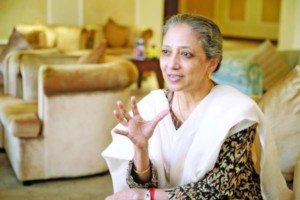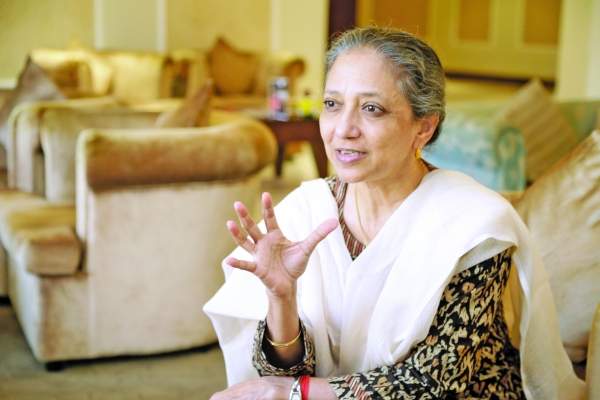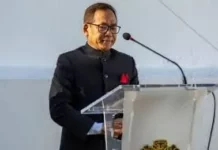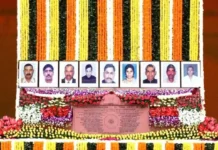 BEIJING: With Indian classical dance forms attracting a large number of youngsters in China, the time is ripe to introduce them in top Chinese universities and cultural centers, Bharatanatyam exponent Leela Samson has said. Samson, 67, who has a big following of Chinese students, is in Beijing this week where she along with popular Chinese Bharatanatyam dancer Jin Shan Shan trains batches of students, mostly girls around the age of 14 years.
BEIJING: With Indian classical dance forms attracting a large number of youngsters in China, the time is ripe to introduce them in top Chinese universities and cultural centers, Bharatanatyam exponent Leela Samson has said. Samson, 67, who has a big following of Chinese students, is in Beijing this week where she along with popular Chinese Bharatanatyam dancer Jin Shan Shan trains batches of students, mostly girls around the age of 14 years.
Jin, a regular performer at the Indian Embassy events and frequent traveler to India, teaches about 100 students, including those at the prestigious Central Conservatory of Music in Beijing. The Indian Embassy itself has a cultural centre where Indian music and dance forms are taught.
“I have been coming to China for many years to perform and to teach. Each time, I am amazed at the level of interests among the youths here to learn Indian classical dance and music forms,” Samson told Press Trust of India. To learn Bharatanatyam, students are not only coming from Beijing and Shanghai but also from the neighboring areas, the noted Bharatanatyam dancer, choreographer and instructor said.
Bharatanatyam and Kathak, India’s most celebrated classical dance forms came to China during the Mao Zedong era when China went through the convulsions of the Cultural Revolution (1966-76) which criticized classical dance and arts as bourgeois habits. Late Chinese dancer Zhang Jun brought Bharatanatyam and Kathak to Mao’s China in the 1950s through her five-decade long career making a big mark in the minds of many aspiring Chinese dancers.
Zhang’s enthusiasm and commitment for the art and culture had not been dampened though she was banished to the villages in Hebei province to work in farms during the Cultural Revolution. “Zhang and several Chinese lovers of Bharatanatyam made huge sacrifices to spread them in China and it has been carrying forward from generation to generation,” Leela said.
Now, seeing the way Yoga and Indian films have been striking a chord with the Chinese, it is time for the governments of China and India to think of institutional arrangements,” she said.
Indian classical dance forms should now step out of the Indian cultural centers to classrooms of different universities in China, she said. “Already Indian languages like Hindi and Tamil are being taught in some of the Chinese universities. Why not dance forms like Bharatanatyam, Kathak etc is taught through a regular curriculum with trained teachers,” she said.
“If Prime Minister Narendra Modi’s dream of spreading Indian culture is to materialize, you have to take it away from cultural centers and make it large. That means having teachers in couple of universities and big cultural centers and conservatories,” she said. “That should definitely be the next step. If we do that we can definitely nurture it well. I can tell you they will be interested. They are already into Indian films. They like the sound of our languages. They tap their fingers to the rhythm of our music and each share certain bonding,” she said.
Unlike the US and the west where popular dance forms existed, here you are talking about huge meeting grounds,” she said, referring to the way 14-year-old girls striking a right expression on a 300-year-old Tamil classical song. “This should be nourished through institutional arrangements,” she said. She admits providing trained teachers for classical dancers are a challenge.
“Getting teachers is a problem. We have performers who teach. Performers are selfish. Not every performer can be a teacher. Teachers specialize in teaching,” she said, adding the courses with special curriculum should be designed to get teachers.
Indian dance forms have become very popular in Russia, Italy and China where the locals are interested in them whereas elsewhere the Indian Diaspora dominated cultural scene, she said. Therefore, special efforts need to be made in these countries to provide bigger platforms for youth to learn, she said.
Also the Indian cultural institutions especially in Chennai, where popular Bharatanatyam institution the Kalakshetra existed, more overseas dancers should be given chances to study and perform in famous events like the annual Chennai dance and music festival, she said. PTI







